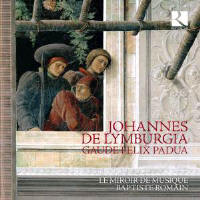Texte paru dans: / Appeared in: Ricercar |
|
| " Warmly recommended. " | |
|
Reviewer: Barry
Brenesal In trolling the waters of so-called early music, we’re used to hearing of composers of whom very little is known. But Johannes de Lymburgia (c. 1380–c. 1440) is by all accounts the poster boy for inductive reasoning. We know literally nothing about his birth, his death, his youth, his family, or his training. A musician of this name became cantor in 1408 in Liège’s Church of St. John the Evangelist. He is also mentioned as the canon appointed to lead the collegiate church choir in 1426.
Meanwhile, a certain Giovanni di Francia (Francia referring here to sections of Charlemagne’s empire that were split among his children, with modern Belgium part of both Western Francia and the so-called Middle Kingdom or Middle Francia) is named in records as receiving a benefice in Padua in 1424. He is then listed as part of the entourage of the politically astute, artistically spendthrift Bishop of Vicenza, Pietro Emiliani, who moved his household from Padua to Vicenza in 1427. Giovanni’s name no longer appears in Italian records after April 1435, but Johannes de Lymburgia is listed as a canon the following year at Notre-Dame in Huy, near Liège. At some point, he vanishes from view. All the surviving works we have bearing the name of Johannes de Lymburga, 46 in total, are part of a larger manuscript labeled Q15. The section devoted to his music was compiled between 1430 and 1435—in Vicenza, where other sources only mention Giovanni di Francia. (Several anonymous movements forming part of a Mass Ordinary and bearing appreciable similarities to Johannes’s style are included in the extensive Trent Codices. These are currently attributed to him, as well.)
To add to the confusion, Reinhard Strohm, in The Rise of European Music, writes that “At Vicenza, Bertrand Feragut and Johannes de Lymburgia were followed, in the 1460s, by Johannes de Francia….” (In fairness to Strohm, however, his work was published over a quarter of a century ago, and hasn’t been updated since. It’s not surprising a few of its facts may require revision, while the book remains the fine resource it has always been.)
So were our Flemish canon and Emiliani’s canon one and the same, referred to as “di Francia” in the Italian States and “de Lymburga” in Liège? Did he actually maintain regular contact and active participation with the ecclesiastical powers-that-be in Liège while spending more than a decade occupying positions that required a high level of both musical and administrative ability in Padua and Vicenza? Or were there two Frankish Johannes, a common enough name, each a canon held in considerable regard in the Low Countries or the Italian States? Stylistically, the music of Johannes bears some similarities to early Dufay in its procedures and harmonic stability; and at other times, Ciconia comes to mind. (The latter is perhaps not surprising, as Ciconia was originally from Liège, arrived in Padua in 1401, and worked for the city’s Cathedral until his death in 1412. Johannes arrived a little over a decade later. He would have become familiar with some of Ciconia’s sacred music that remained in the active religious repertoire, possibly his madrigals and virelais.) There are also a few indications he might have been familiar with works of some of the so-called Trecento composers. His regular use of an under-third cadence—once termed the Landini cadence because the blind Florentine organist used it frequently—hardly qualifies as proof of anything, any more than does his expert and occasionally quixotic counterpoint, but they both are symptomatic of the varied influences to be found in Johannes’s music.
He is occasionally experimental, as well, though the word personal might be a better fit, as he evolves elements of his musical vocabulary over time that then become among its standard features. The erudite liner notes, written by Baptiste Romain, suggest as an example Johannes’s four-voice Magnificat, which “makes use of a dozen highly dissonant harmonic sequences,” which just might be a personal response to some of the less extravagant examples of the no-longer-current Ars subtilior movement that came his way. By contrast, his strophic songs in Latin are understandably easier to sing and more homophonic, with a strong folk element in both the texts and music—particularly in the concluding selection on this disc, a rapt and lovely Salve Virgo regia.
Baptiste Romain’s Le Miroir de Musique’s core group of four instrumentalists (portative organ, plucked and bowed strings) perform three arrangements without voice on this album. They are joined by four vocalists in 12 other selections. All are excellent, both in solos and as an ensemble. The sound is forward and well balanced, with good resonance.
| |
|
|
|
|
|
|
|
Cliquez l'un ou l'autre
bouton pour découvrir bien d'autres critiques de CD |
|




